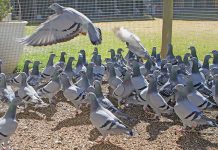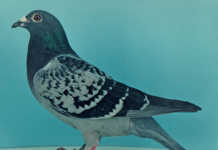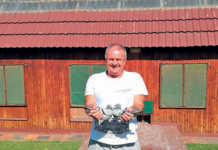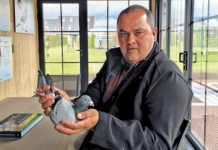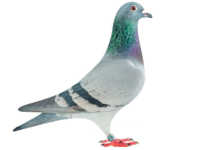“My pigeons also have wings, they can fly.” This is a favourite line at pigeon clubs – by this a competitive fancier means, “Watch out my pigeon can beat yours or might just surprise you on race day!”
As wing design play a very important part in racing, there are clear guidelines as to which wing design will be the most effective. The wing consists of the 10 primary flight feathers, which are the section furthest from the body when the wing is extended. The secondary flight feathers are the closest to the body. A one-third to two-third structure is the ideal with the primary feathers comprising the greater part. When extended, the coverage of the secondary feathers over the back need not be exaggerated.
Quest for the perfect wing
Here’s a list of some of the “rules” specialists follow in their quest for the perfect wing:
- Match more louvred primary feathers to less louvred primary feathers.Match fewer louvred primary flight feathers to well louvred primary feathers.
- Match wings with extra louvres between all primary feathers (open wing) to no louvres (closed wing). Counting from the first primary feathers, extra louvres are often found between primary feathers six to 10. It must show some umbrella design when extended.
- Avoid secondary feathers that louvre too much – the primary feathers must louvre to allow wind to escape with the upstroke, not the secondary feathers.
- Match an umbrella to a flat wing. (Don’t match two flat wings for a one-day loft competition.)
- Extended spanning (not only in long wings, but in any wing length). This occurs when the wing joint at the shoulder and the connection at the hand, swing a little further and allows for full use of the surface.
- The focus point of the spanned wing should be at the tip of the first primary feather. Despite a step-up from the first primary feather, the spanned wing that shows a straight line at the wing tips places the burden of the workload on the outer primary feathers. That’s why these curve upwards during prolonged flight. A little umbrella combined with a little louvre and rounding above the shoulder is needed to balance the wing.
- A rounded curve along the top of the shoulder adds lift, because the airflow moves faster over the wing to catch the flow beneath. Mating such a wing with a flat wing restores the balance both ways.
- A shorter 10th primary feather compared to primary feathers 8 and 9 is not a disqualification. Match wings with a shorter 10th primary feather to a partner with outer primary feathers more equal in length.
- Match wings with some step-up to the first primary feather from the secondary feathers to wings with no step-up. Never mate two wings that have extended step-ups to the primary feathers. This will make the secondary feathers’ area too small.
- Step down to secondary feathers is a disqualification (so-called “sparrow wing”).
- Don’t match two flat long wings as a rule. A medium between long and short should be found depending on the length and size of the pigeon.
- Match pigeons with sharpened wing tips (the English/Scottish trait) to rounder wing tips (the Belgian trait).
- Match narrow wing flights of the outer primary feathers to broader flights.The arm bone connects the wing to the body – match longer arms to shorter arms as pigeons with longer arm bones tire faster. Match a long arm bone to an extra-short one.
- Match arm bones with embalming muscle extending from the greater pectorals to less-muscled pigeons – it’s good if there’s some flesh on the wing.
- Zero coverage of the secondary feathers over the back isn’t a disqualification if the wing-body connection is perfect.
- Study the wings of champions and average pigeons, and compare the race velocity and conditions they flew in. Remember to look at the pigeon and its pedigree and then follow your gut. Have faith in your pigeons and don’t get carried away by a single dogma.


